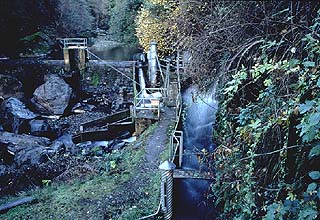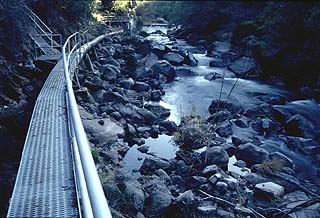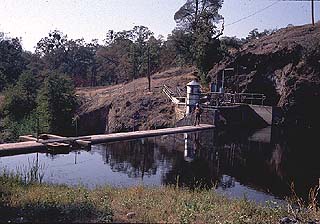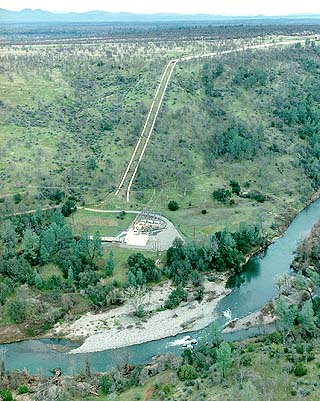

 |
 |
|
Industrial and
Hydroelectric Development
![]()
Text on this page is from the Battle Creek Salmon and Steelhead Restoration Plan by Kier Associates. (1998)
By the turn of the century, urban growth and industrial development strained the area's fuel resources. Massive amounts of timber were consumed to fire the boilers of steam-powered mining machinery and to operate smelters. The pressure placed on the local wood fuel supply to support the urban growth and mining was probably the primary incentive to develop hydroelectric power in Shasta and Tehama counties (Reynolds and Scott n.d.). The Battle Creek Hydroelectric Project was a principal result of that effort (CDM 1947).
Hydroelectric development began on Battle Creek with the construction of Volta Powerhouse by Keswick Electric Power Company in 1901 (USRFRHAC 1989). This was followed by South and Inskip Powerhouses in 1910 and Coleman Powerhouse in 1911. This system of powerhouses was acquired by Pacific Gas and Electric Company (PG&E) in 1919. The project initially was licensed by the Federal Power Commission in 1932 and was relicensed in 1976 for a period of 50 years. Volta II Powerhouse was constructed in 1980.
As it exists today, PG&E's
Battle Creek Hydroelectric Project (FERC No. 1121) consists of: five powerhouses
(Volta, Volta II, South, Inskip, and Coleman), two small storage reservoirs
(North Battle Creek and Macumber), three forebays (Grace, Nora, and Coleman),
five diversions on North Fork Battle Creek , including the North Battle Creek
Feeder, Eagle Canyon, and Wildcat, three diversions on South Fork Battle Creek
(South, Inskip, and Coleman), numerous tributary and spring diversions, and
a network of some 20 canals, ditches, flumes and pipelines.
 |
 |
| Eagle Canyon Dam, on the North Fork of Battle Creek. Note that most of the water is being diverted into the canal at right. The restricted flows under minimum FERC requirements leave minimal habitat for spring chinook salmon. | Wildcat Dam, also on the North Fork Battle Creek, has also removed substantial amounts of water from the stream for power generation. |
 |
|
| Inskip Dam, in the middle reaches of the South Fork of Battle Creek, delivers water to the Inskip Powerhouse, further downstream. | |
 |
|
| The coleman Powerhouse on lower Battle Creek, is driven by water collected from both the North and South Forks of Battle Creek. Water is also shunted to Coleman National Fish Hatchery from this facility. |
References
Ward, M. B. and W.M. Kier, 1999. Battle Creek salmon and steelhead restoration plan. Prepared for the Battle Creek Working Group by Kier Associates. Sausalito, CA . 157 pp. [1.4 Mb]